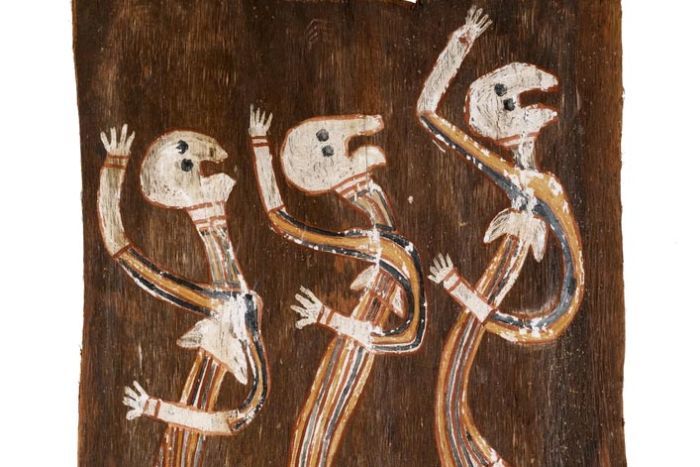
Jack Karedada, Namarali – The First One.
Photo: courtesy Sotheby’s.
The first-ever sale of Aboriginal art at Sotheby’s London on June 10 was an unexpected success, bringing in over $2 million for 75 lots.
The auction was mostly drawn from the collection of Dutch billionaire Thomas Vroom. A total of 83 percent of the lots found buyers, and several were well over their pre-sale estimates.
“It was a bit of a risk to put a sale of Aboriginal art outside Australia,” Sotheby’s senior Australian Art consultant Tim Klingender told ABC Australia. “I wondered whether there was enough global interest to support it, but I was absolutely astounded by the results and the market and the bidding.”
Emily Kame Kngwarreye, Wild Yam 2.
Photo: courtesy Sotheby’s.
Five works sold for over $100,000, including Jack Karadada’s Namarali – The First One, which tied Emily Kame Kngwarreye’s Wild Yam 2 (1995) as the most expensive lot of the evening at £100,000 ($154,000). Karedada’s painting on eucalyptus bark was expected to fetch £10,000–15,000 ($15,000–23,000), but went on to smash the existing world record for bark paintings.
The market for Aboriginal art has struggled in recent years, as issues with authenticity, ownership, and exploitation become more recognized.
Paddy Compass Manatbara, Mimih Spirit Women Dancing.
Photo: courtesy Sotheby’s.
Further hindering the market is Australia’s Movable of Cultural Heritage Act, restricting the export of indigenous art as a means of protecting the island nation’s cultural heritage. Vroom’s collection could only be sold because it predated such legislation, which is currently under review from the country’s arts minister.
With yesterday’s sale showing signs of a renewed interest in Aboriginal art, Klingender is hopeful that Australia will repeal the law and help stimulate the market.
The regulations “just quite plainly don’t work and they’ve really stymied the Aboriginal art market,” he told ABC Australia.”If it’s not secret [or] sacred, [Aboriginal art] should be able flow freely just like any other art, and I’m sure indigenous people feel that too.”